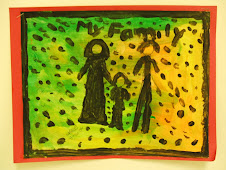
Muslims follow Madhhab; these are Islamic school of thought or (figh) religious jurisprudence. There are four; the Hanafi, the Maliki, the Shafi’i and the Hanbali.
In the art world there are also schools of art according to style or a movement as belonging a particular group of artists. These artists have a common influence or origin. It is not a physical school but reflects the style of art around that time.
Islamic art is not easily recognizable because Muslims vary from nation to nation except if it is traditional in nature; e.g. Arabic calligraphy or the architecture of a Masjid.
But the one feature which would indeed unify Muslim artists would be the belief that to draw realistic images of people and animals are forbidden. Also not only to create these images but also the way that they are used. Still with the vast array of media and medium it would be difficult for all contemporary Islamic art to look the same. My guess is that it would also reflect the culture of the artist, his style, the medium he uses, the influences which are endless and so much more.
It would be extremely interesting to see what an actual Islamic Art School would be like. Well there's a link to a traditional school .
http://www.psta.org.uk/index.php?n=Main.Homepage
This one in Pakistan seems more secular than Islamic.
http://www.nca.edu.pk/index.htm









